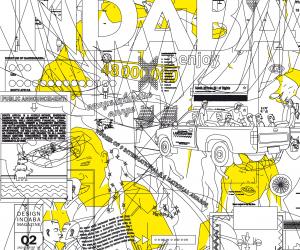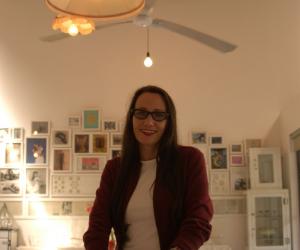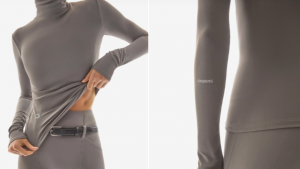First Published in
Amanda Laird Cherry is one of South Africa's most established fashion designers, renowned for fusing the development of her clothes with that of the country. On the ramp, she is both an artist and a storyteller, telling personal and political stories with cloth and thread, in much the same way that cultures have done all over the world even before the construction of the first needle. Co-owner of the Space boutiques around the country, and supplier to the Big Blue franchise, Laird Cherry is also stocked by Liberty in London. The Amanda Laird Cherry label includes her ladieswear, shoes and private commissions, while the ALC label is a range of ready-to-wear men's clothes.
As a designer, you are most widely known for incorporating diverse cultural references in your work, including the Sophiatown Fifties, Xhosa blankets, traditional Zulu dancing garb, shweshwe fabric and even Oriental and Indian influences. Tell us about your approach to appropriation.
I have an innate love for our country and am fascinated with how people all over South Africa have such interesting, different ways of dressing. Pockets of people have adapted clothes to reflect themselves and their culture. Here I am not only talking about what one sees in remote rural areas, where blankets or beads may feature, but also in the bigger cities. For example, "amapantsula" was a 1970s and 1980s urban trend of dressing, using formal elements that may have been inspired by Sophiatown, but was adapted and updated.
I have memories from road trips when I was very young, when my mom drove us kids from Cape Town to Durban, seeing people on the side of the road wearing outfits that intrigued me. I was unfamiliar with the mblaselo pants and patches, colour combinations and wrapping of cloth, but I was drawn to them in a special way.
When I studied fashion design I got the chance to express this interest and used shweshwe fabric in my graduation range in 1983. The styling was a mixture of Zulu and Oriental influences. Ever since, I have continued to explore many interesting South African references in my ranges, not in a contrived forced way, but because when I think about what inspires me at each given time, that is what is in my head.
I feel it necessary to explain that its not appropriation in a negative way, but rather as an appreciation that I need to share, done in my medium - fashion. My hope is that through this, other people may be prompted to explore our country and its cultures for themselves, or at least that by attending the shows, people may be exposed to something that they may not have really looked at properly before. It has always been my goal that the clothes portray respect, while not using the references directly but extending them and making them different, so that they relate to worldwide trends and current looks.
Since about 2006, there seems to have been a shift in this approach, with your cultural references becoming increasingly more conceptual and mediated before appearing in your work. How would you describe the shift?
After using shweshwe for so many ranges it was time to explore other fabrics, particularly those that had a softer feel with more drape, and to explore a range without any prints in it. So when I thought through my inspirations, the influence of cultural elements took an interesting turn. I like the description "conceptual and mediated" as this is exactly how I wanted it to come across - clothes that had a base influence in our culture but that could be relevant anywhere around the world. I wanted to be more architectural and for the references to be toned down and even subliminal.
Your 2007 Winter Collection was inspired by the Ndebele culture, yet it seemed both Victorian and futuristic at the same time. Can you explain how you brought all of this together?
I have always had an aversion to the way that the Ndebele aesthetic has been copied on to other applications like homeware; always so literally, including using the exact bright colours. So I challenged myself to do it differently, and have to admit that I tried to use the influence for many years and failed to include or adapt it to my clothes. Then in 2007, when I was keen to work in felt and sombre colours, visual references of Ndebele ladies in their attire kept coming into my head.
I love the long strips of Nguni hide that are worn down the back of a married women's outfit, and I used this in different ways throughout the range - in wide strips of pure silk on the back of a man's coat and a woman's jacket, asymmetrically down the front of a pencil skirt, on to a silky crossover camisole and more. Not using any of the bright colours was a conscious decision. They also wear very interesting head-wrap-come-hats, of which I developed my own version.
Interestingly, the styling of most of the shweshwe dresses that one can buy from street vendors has a distinct Victorian influence to this day. So, in this way I continue to allude to shweshwe, without actually using it in the range. Also I am very conscious of trying to make head or tail of what's in the future for us in this country, and so my styling has been playing with this in my current ranges.
Just as we as people have many sides to our character, so I feel that my ranges have different aesthetic and emotional aspects. In our lives we have to play out roles that encompass our nurturing compassionate side, as well as our efficient business side, not to mention our feminine emotional side, and so on. Similarly, with my clothes I cannot always focus on only one look, and need to embrace and explore all of these. Here I found that combining old (Victorian) and new (futuristic), mixed up with local cultural influences, expressed where I was at, and what was in my heart.
You have often spoken about fashion being political and wanting to design clothes that reflect our South African climate. Please tell us about your 2007 Summer Collection, which engaged with our country's prevailing optimism as well as the darker realities of HIV/Aids.
The range was divided into two parts and included as many real people on the ramp as it did models. In the first half I showed more wearable garments in bright colours; this represented the first 10 years of democracy, displaying the euphoria of averted civil war, the optimism of new beginnings and the hope for things to improve. The model sequence alternated a professional with a real person - i.e. people not normally found on the ramp. I wanted to express real life and show characters from different professions in our country - included were a lawyer, yoga teacher, IT specialist, intellectual student, professional ballet dancer, fashion stylist and others. These people sat on the ramp on two benches, watching the models - which was about pre-democracy people waiting for reality to happen. The styling of the clothes in this section was more casual and wearable, reflecting everyday life.
Then there was a planned blackout halfway through, representing our load shedding. I changed the props, replacing the wooden benches with refined designs - a streetlight-inspired lamp, a simple bench and a table inspired by a street block in Gauteng. The second half was a lot more sophisticated with muted colours and more considered, formal styling. This spoke about how we in our country need to be more organised and proactive about what we do and how we do it. Save energy, treat people with respect and compassion, work hard and be ordered; be relevant and world class in your approach to whatever you do.
Throughout both halves were T-shirts that had graphics of beetroots, garlic, aloes, sutherlandia, echinacea and other plants - all things that are immune boosting. It was a statement relating to that comment by our health minister a while back. These were embellished by the Hillcrest Aids Centre as part of an ongoing project where 20% of the sales of these T-shirts go to the centre. This took the message of HIV/Aids through where we've been since 1994 and where we are now, asking that we remember our country's problems and our commitment to looking for solutions.
You have mentioned before that if it hadn't been fashion, you would have gone into theatre. At the Design Indaba Expo this year, you collaborated with Jay Pather to present your collection. Can you tell us the story of this collection?
The range was born from an interesting exercise. I had two students do an internship with me during the December vacation and I asked them to go through my archives of past shows and come up with outfits or garments that reflect my brand. It was remarkable how they started with a colonial feeling that had a distinct Edwardian slant, but what transpired was like sliding through modes of dress from all cultures since the 1820 Settlers. The range was an extension of this exercise and we used it in a charity show for the Sunflower Fund.
When the opportunity came to show at Design Indaba - thanks to Spice for Life - I wanted to expand on this concept, and the chance to collaborate with Jay Pather was very exciting and a real privilege. It was great to explain my inspirations and ideas to him, and then see him interpret them in dance theatre. He came up with an outstanding installation that portrayed the vision perfectly. One of the scenes explored how the settlers wanted to cover up the people who were living around them; the styling was so Victorian and foreign it was ridiculous. Jay treated this in a perfectly comical way that communicated the message powerfully. Historical imagery and video footage displayed marches and people walking, as well as maps from around the country. What resulted was a more conceptual and avant garde range, which portrayed a fusion of time, race and gender.
There seems to be a more contemporary story of South Africa in your most recent 2008 Winter Collection, which combined elements of the traditional Western dress suit and mblaselo pants worn by migrant workers. Can you tell us about the current environment that you are reflecting?
The range is about the fact that everyone has something to contribute and the incredible way how, in our country, we can learn very interesting things from each other. The history of mblaselo pants is undocumented but fascinating. I love the fact that a formal Western piece of clothing was transformed into something that had such a strong African aesthetic. From what we can gauge, migrant workers adapted suit trousers or work pants to impress the girls when they went home. Basically, patches and triangles were sewn on to the pants, most often in bright colours, and then braid was used to edge the triangles - sometimes even tasselled braid. It may have started out as a solution to covering holes but the end result, which is still produced and worn today, has strong cultural ties and is iconic for many people. One of my favourite accounts of mblaselo is of a man who took three pairs along when he went into exile. Years later when he returned, he couldn't wait to have more made as his own had been begged off him while in Europe.
My reference in the Winter 2008 Collection was very subtle and mblaselo was primarily represented by a seam on the back of the pants that formed a "V" to allude to the patched triangles. In a way, mblaselo pants are a form of appropriation and now I am appropriating the appropriation. I love this cross-pollination and this is where I feel we continue to learn from each other in a positive way. So, the current environment I wanted to reflect is of striving to improve, together.
Another main inspiration for the range was the "Laws of our Land" and "Courts of Law" - represented by the bibs and leggings that the guys wore. The historical image of barristers wearing wigs, ruffled shirts and tights was updated to a current, perhaps slightly futuristic, aesthetic. This reflects my desire that our country holds on to what is fair and right, and keeps things under control through the law system.
With your skirts, doilies, aprons and saris for men, you certainly don't have a conventional attitude towards gender distinction. What is the story you are telling about the contemporary sexes?
In many of my ranges where I have used skirts, saris or aprons on men, the references are historic. It is not all that long ago that men started wearing trousers. To this day, men still wear wraps instead of pants in parts of Africa. The skirts are a direct adaptation of the Scottish kilt (I have Scottish heritage - Laird) and, years ago, I was also fascinated to discover that there is a group of men who walk the annual Shembe Mountain pilgrimage in kilts. The wearing of animal skins by local men, also not that long ago, has intrigued me since I was young - my dad used to take us to tribal dancing displays with groups from the horseracing stables. So, my focus is more aesthetic than a statement on the contemporary sexes.
That said, I have always questioned the overt chauvinistic attitude that so many South African men display - more in the past though, the younger generation has shown a shift. Perhaps this continued thread in my ranges is a reaction to the unnecessary male dominance. My recent use of crocheted doilies seemed an appropriate way of expressing how younger guys are able to pull off and enjoy creative aesthetic looks outside of the norm. They don't view gender-associated looks the same way anymore. Men are a lot more involved in sharing household chores and raising kids than in my father's generation. I would like to push the boundaries even further.































